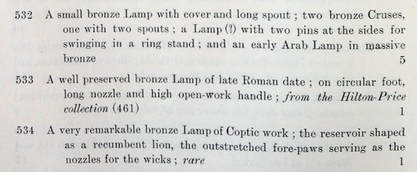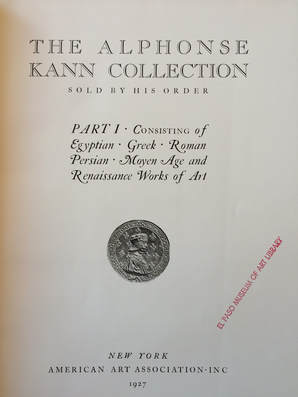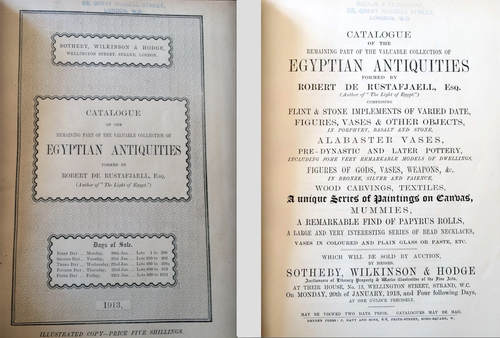Even better, this record gives more information about the material of the lamp - it was bronze, not the more common and expected terracotta. A bronze Roman lamp - great.
What are the next steps? For one, I requested a copy of the original purchase of the lamp made by Knoedler: that from Sotheby, Wilkinson and Hodge, earlier in 1913. Lo and behold, a couple of bronze lamps are listed for sale from the Egyptian collection of Robert de Rustafjaell, Esq., British collector and fellow of the Royal Geological Society:

(right) Bronze lamps, including one from the Hilton-Price collection
Is it possible that no. 533 is the bronze lamp that Knoedler bought and then sold to Alphonse Kann?

(left) 1927 catalogue of the auction of Alphonse Kann's antiquities
The final step - for now - in this little journey was to search the ERR Jeu de Paume database. This website documents the Cultural Plunder of the Einsatzstab Reichsleiter Rosenberg (ERR), a "Special Task Force" of Hitler that looted art objects from French and Belgian collections during WWII. Had Kann left the lamp in France when he fled his home, it may be listed in here. Indeed, there are over 1600 objects associated with Kann in the database, and well over 200 with the tag of "Antiquities."
But no Roman lamp. Yet.
The mystery of the Roman lamp bought by Knoedler and sold to Kann remains unsolved, but the journey and the pieces I've stitched together have, I hope, been at least somewhat enlightening for seeing the challenges (and rewards!) of tracing antiquities provenance. In the meantime, I'd love to hear any thoughts and comments you might have. There are so many avenues to travel in provenance research, and so much more to explore.

(right) Mouse-shaped (??) bronze oil lamp
from the Near East, 9th-11th cent. AD.
Formerly Alphonse Collection, Paris.
ETA: For a great video and text outlining the importance of the ERR documents for the restitution of works stolen during WWII, read here.
My thanks to Judith Barr and David Saunders for their
helpful suggestions in researching and writing these posts.






 RSS Feed
RSS Feed